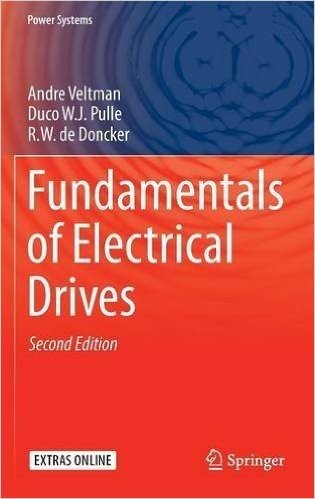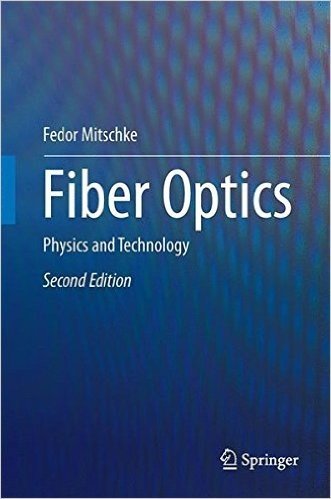Fundamentals of Electrical Drives baixar mp3
Electrical drives consist of a number of components, the electrical machine, converter and controller, all of which are discussed at various levels. A brief resume of magnetic and electrical circuit principles is given in chapter 1 together with a set of generic building modules which are used throughout this book to represent dynamic models. Chapter 2 is designed to familiarize the reader with the process of building a dynamic model of a coil with the aid of generic modules. This part of the text also contains an introduction on phasors as required for steady state analysis. The approach taken in this and the following chapters is to present a physical model, which is then represented by a symbolic model with the relevant equation set. A generic model is then presented which forms the basis for a set of build and play simulations set out in various steps in the tutorial at the end of the chapter. Chapter 3 introduces a single phase ideal transformer (ITF) which forms the basis of a generic transformer model with leakage and magnetizing inductance. A phasor analysis is given to familiarize the reader with the steady state model. The build and play tutorials at the end of the chapter give the reader the opportunity to build and analyse the transformer model under varying conditions. It is emphasized that the use of these build and play is an essential component of the learning process throughout this book. Chapter 4 deals with star and delta connected three phase systems and introduces the generic modules required to model such systems. The space vector type representation is also introduced in this part of the text. A set of build and play tutorials are given which reinforce the concepts introduced in this chapter. Chapter 5 deals with the concepts of real and reactive power in single as well as three phase systems. Additional generic modules are introduced in this part of text and tutorial examples are given to familiarize the reader with this material. Chapter 6 extends the ITF concept introduced earlier to a space vector type model which is represented in a symbolic and generic form. In addition a phasor based model is also given in this part of the text. The build and play tutorials are self-contained step by step simulation exercises which are designed to show the reader the operating principles of the transformer under steady state and dynamic conditions. At this stage of the text the reader should be familiar with building and using simulation tools for space vector type generic models which form the basis for a transition to rotating electrical machines. Chapter 7 introduces a unique concept namely the ideal rotating transformer (IRTF), which is the fundamental building block that forms the basis of the dynamic electrical machine models discussed in this book. A generic space vector based IRTF model is given in this part of the text which is instrumental in the process of familiarizing the reader with the torque production mechanism in electrical machines. This chapter also explores the conditions under which the IRTF module is able to produce a constant torque output. It is emphasized that the versatility of the IRTF module extends well beyond the electrical machine models discussed in this book.These advanced IRTF based machine concepts are discussed in a second book Advanced electrical Drives currently under development by the authors of this text. The build and play tutorials at the end of thischapter serve to reinforce the IRTF concept and allow the reader to play with the conditions needed to produce a constant torque output from this module. Chapters 8-10 deal with the implementation of the IRTF module for synchronous, asynchronous and DC machines. In all cases a simplified IRTF based symbolic and generic model is given of the machine in question to demonstrate the operating principles. This model is then extended to a full dynamic model as required for modelling standard electrical machines. A steady state analysis of the machines is also given in each chapter. In the sequel of each chapter a series of build and play tutorials are introduced which take the reader through a set of simulation examples which steps up from a very basic model designed to show the operating principles, to a full dynamic model which can be used to represent the majority of modern electrical machines in use today. Chapter 11 deals with the converter, modulation and control aspects of the electrical drive at a basic level. The half bridge converter concept is discussed together with the pulse width modulation (PWM) strategies that are in use in modern drives. A predictive dead-beat current control algorithm is presented in combination with a DC machine. The build and play tutorials in the sequel of this chapter clearly show the operating principles of PWM based current controlled electrical drives."
MP3 é o tipo de arquivo usado para armazenar músicas ou audiolivros. Aqui está como isso funciona. Nos antigos formatos de música, como gravações LP ou cassetes, era usada a tecnologia analógica, na qual a música era salva como uma representação física ou magnética do som original. Os arquivos de CD ou MP3 são digitais, o que significa que a música é armazenada como números. Enquanto o CD usa um formato de alta resolução não comprimido, o objetivo do MP3 é comprimir o som, mantendo uma qualidade de som comparável a um CD. O MP3 usa compactação de dados com perdas ou, mais simplesmente, elimina informações de áudio para reduzir o tamanho do arquivo. Então, qual informação é descartada? Principalmente sons com freqüências que o ouvido humano não pode ouvir. Ou, se simultaneamente com sons mais suaves um som mais alto, o algoritmo os ignora. Essa técnica é chamada de codificação perceptual ou psicoacústica. Podemos conseguir uma redução de tamanho de 10 vezes. Uma composição de 33 megabytes em um CD pode ser compactada para cerca de 3 megabytes. Graças à taxa de bits, que é o número de bits por segundo, você pode criar dois arquivos MP3 diferentes com qualidade de som e tamanhos de arquivo diferentes a partir do mesmo arquivo de entrada. A taxa de transferência geralmente pode variar de 32 a 320 kilobits por segundo. Com uma taxa de transferência de dados maior, obtemos gravações de maior qualidade. E vice versa. Uma taxa de bits de 128 kbps é provavelmente a mais comum e geralmente dá a qualidade do som que você ouve no rádio. Vamos ver a estrutura do arquivo MP3. Um arquivo MP3 consiste em pequenos pedaços chamados quadros. Cada quadro contém um cabeçalho e um bloco de dados. O cabeçalho de MP3 começa com uma palavra de sincronização usada para determinar o início de um quadro válido e é acompanhada por informações como taxa de bits, frequência ou modo de canal. O bloco de dados MP3 contém informações de áudio atualizadas em termos de freqüências e amplitudes. A maioria dos arquivos MP3 também contém metadados ID3 que armazenam detalhes da faixa, como título, artista, gênero etc. E é isso. O que você acha? A perda de qualidade dos arquivos MP3 é menor ou você prefere formatos sem perdas como o FLAC? E agora você aprenderá a baixar e ler o livro Fundamentals of Electrical Drives em formato mp3. Por favor, note que os arquivos mp3 fornecem áudio sem texto apenas. Os arquivos podem ser baixados para um computador ou qualquer dispositivo que suporte a reprodução de mp3. Para começar, abra um navegador e acesse nosso site. Você pode usar a pesquisa para um livro ou autor específico. Quando encontrar o livro desejado, selecione Download. Os livros estão disponíveis em dois formatos de áudio: mp3 e daisy audio. Mp3 é o formato de áudio padrão. Se você quiser que o livro esteja em formato de áudio, você deve indicar isso em suas preferências. Agora você está pronto para encontrar e baixar livros em formato mp3! Encontre o livro que deseja ler fazendo uma pesquisa ou navegação, selecione "Áudio" no menu suspenso e selecione "Download" Fundamentals of Electrical Drives. Após fazer o download de um livro em formato mp3, você pode ouvir o livro em seu computador usando o media player incorporado ou transferir arquivos para um dispositivo compatível com mp3. Se você usa um dispositivo da Apple, pode usar o iTunes para transferir arquivos para o seu dispositivo. Caso contrário, conecte o dispositivo ao computador e copie o arquivo mp3 ou arquivos para o dispositivo de acordo com as recomendações do fabricante. Transferir arquivos para o seu dispositivo Apple é muito fácil! Conecte seu dispositivo ao seu computador e abra o iTunes. Crie uma pasta no iTunes na seção "Playlists". Para fazer isso, selecione “Nova pasta de lista de reprodução” no menu “Arquivo”. Nomeie sua nova pasta como algo como “Books mp3s”. Em seguida, crie uma nova lista de reprodução na nova pasta, selecionando "Nova lista de reprodução" no menu Arquivo. Chame a playlist do título do livro Fundamentals of Electrical Drives que você baixou. Repita este passo para cada cabeçalho carregado. Arraste a pasta com o livro de mp3 da pasta no seu computador para a lista de reprodução especificada no iTunes. Alguns audiolivros possuem vários arquivos ou capítulos. Certifique-se de selecionar todos os arquivos. Sincronize seu dispositivo. Certifique-se de que a lista de reprodução esteja configurada para sincronizar na guia Música. Agora você está pronto para ouvir o livro do livro.
MP3 é o tipo de arquivo usado para armazenar músicas ou audiolivros. Aqui está como isso funciona. Nos antigos formatos de música, como gravações LP ou cassetes, era usada a tecnologia analógica, na qual a música era salva como uma representação física ou magnética do som original. Os arquivos de CD ou MP3 são digitais, o que significa que a música é armazenada como números. Enquanto o CD usa um formato de alta resolução não comprimido, o objetivo do MP3 é comprimir o som, mantendo uma qualidade de som comparável a um CD. O MP3 usa compactação de dados com perdas ou, mais simplesmente, elimina informações de áudio para reduzir o tamanho do arquivo. Então, qual informação é descartada? Principalmente sons com freqüências que o ouvido humano não pode ouvir. Ou, se simultaneamente com sons mais suaves um som mais alto, o algoritmo os ignora. Essa técnica é chamada de codificação perceptual ou psicoacústica. Podemos conseguir uma redução de tamanho de 10 vezes. Uma composição de 33 megabytes em um CD pode ser compactada para cerca de 3 megabytes. Graças à taxa de bits, que é o número de bits por segundo, você pode criar dois arquivos MP3 diferentes com qualidade de som e tamanhos de arquivo diferentes a partir do mesmo arquivo de entrada. A taxa de transferência geralmente pode variar de 32 a 320 kilobits por segundo. Com uma taxa de transferência de dados maior, obtemos gravações de maior qualidade. E vice versa. Uma taxa de bits de 128 kbps é provavelmente a mais comum e geralmente dá a qualidade do som que você ouve no rádio. Vamos ver a estrutura do arquivo MP3. Um arquivo MP3 consiste em pequenos pedaços chamados quadros. Cada quadro contém um cabeçalho e um bloco de dados. O cabeçalho de MP3 começa com uma palavra de sincronização usada para determinar o início de um quadro válido e é acompanhada por informações como taxa de bits, frequência ou modo de canal. O bloco de dados MP3 contém informações de áudio atualizadas em termos de freqüências e amplitudes. A maioria dos arquivos MP3 também contém metadados ID3 que armazenam detalhes da faixa, como título, artista, gênero etc. E é isso. O que você acha? A perda de qualidade dos arquivos MP3 é menor ou você prefere formatos sem perdas como o FLAC? E agora você aprenderá a baixar e ler o livro Fundamentals of Electrical Drives em formato mp3. Por favor, note que os arquivos mp3 fornecem áudio sem texto apenas. Os arquivos podem ser baixados para um computador ou qualquer dispositivo que suporte a reprodução de mp3. Para começar, abra um navegador e acesse nosso site. Você pode usar a pesquisa para um livro ou autor específico. Quando encontrar o livro desejado, selecione Download. Os livros estão disponíveis em dois formatos de áudio: mp3 e daisy audio. Mp3 é o formato de áudio padrão. Se você quiser que o livro esteja em formato de áudio, você deve indicar isso em suas preferências. Agora você está pronto para encontrar e baixar livros em formato mp3! Encontre o livro que deseja ler fazendo uma pesquisa ou navegação, selecione "Áudio" no menu suspenso e selecione "Download" Fundamentals of Electrical Drives. Após fazer o download de um livro em formato mp3, você pode ouvir o livro em seu computador usando o media player incorporado ou transferir arquivos para um dispositivo compatível com mp3. Se você usa um dispositivo da Apple, pode usar o iTunes para transferir arquivos para o seu dispositivo. Caso contrário, conecte o dispositivo ao computador e copie o arquivo mp3 ou arquivos para o dispositivo de acordo com as recomendações do fabricante. Transferir arquivos para o seu dispositivo Apple é muito fácil! Conecte seu dispositivo ao seu computador e abra o iTunes. Crie uma pasta no iTunes na seção "Playlists". Para fazer isso, selecione “Nova pasta de lista de reprodução” no menu “Arquivo”. Nomeie sua nova pasta como algo como “Books mp3s”. Em seguida, crie uma nova lista de reprodução na nova pasta, selecionando "Nova lista de reprodução" no menu Arquivo. Chame a playlist do título do livro Fundamentals of Electrical Drives que você baixou. Repita este passo para cada cabeçalho carregado. Arraste a pasta com o livro de mp3 da pasta no seu computador para a lista de reprodução especificada no iTunes. Alguns audiolivros possuem vários arquivos ou capítulos. Certifique-se de selecionar todos os arquivos. Sincronize seu dispositivo. Certifique-se de que a lista de reprodução esteja configurada para sincronizar na guia Música. Agora você está pronto para ouvir o livro do livro.
- Andre Veltman Autor:
- 3319294083 Isbn 10:
- 978-3319294087 Isbn 13:
- Capa dura Páginas de capa mole:
- Springer; Edição: 2nd 2016 ed. Publisher:
- 708 g Peso:
- 708 g Peso:
- 15,5 x 2,1 x 23,5 cm Dimensões e tamanhos:
- Inglês Idioma Fundamentals of Electrical Drives:
Escolha um formato:
| rating | icon | release | other | uploader | baixar |
|---|---|---|---|---|---|
| 7 |
|
zip Fundamentals of Electrical Drives | uho-solder | baixar | |
| 5 |
|
rar Fundamentals of Electrical Drives | osamawang | baixar | |
| 5 |
|
exe Fundamentals of Electrical Drives | shima | baixar | |
| 6 |
|
apk Fundamentals of Electrical Drives | shima | baixar | |
| 6 |
|
ios Fundamentals of Electrical Drives | shima | baixar |




















